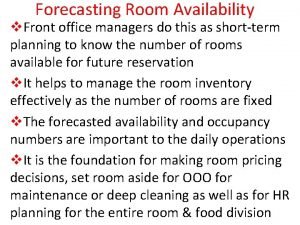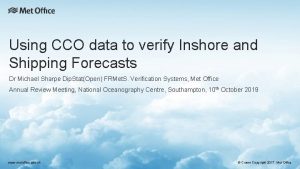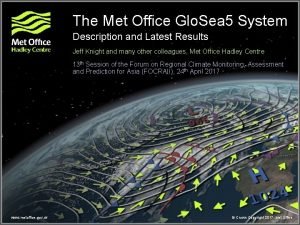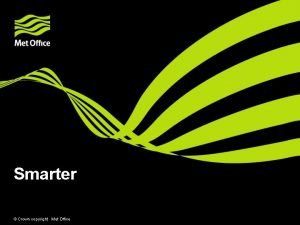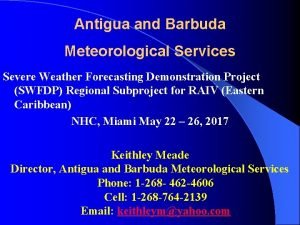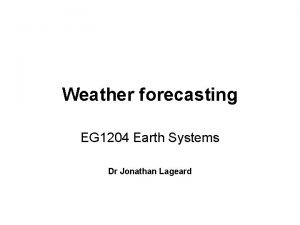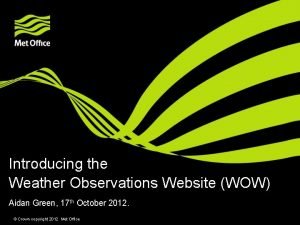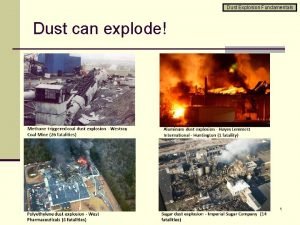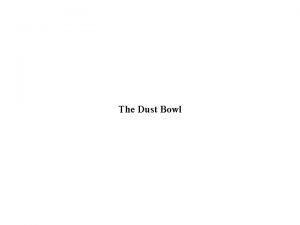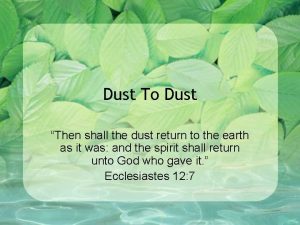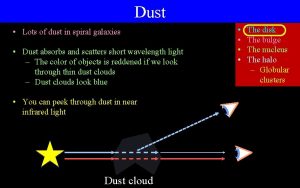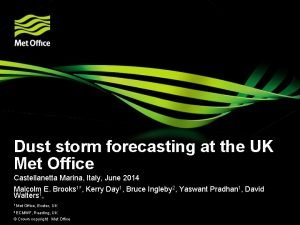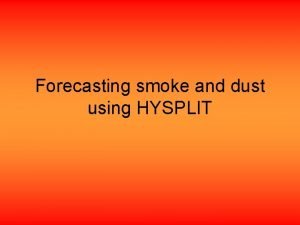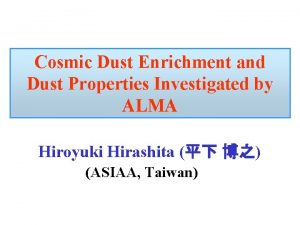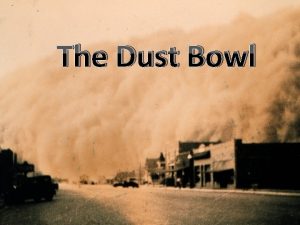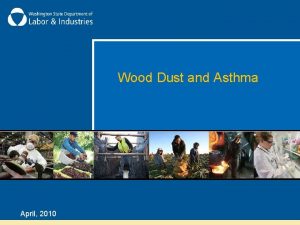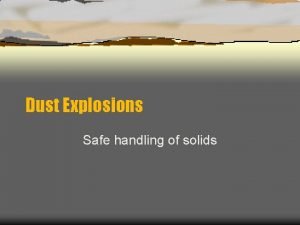Met Office dust forecasting Using the Met Office






















- Slides: 22

Met Office dust forecasting Using the Met Office Unified Model™ David Walters: Manager Global Atmospheric Model Development, Met Office. (with M. E. Brooks, B. Ingleby, B. Johnson, J. Mulcahy, Y. Pradhan) © Crown copyright Met Office

Dust forecasting with the Met. UM © Crown copyright Met Office

Met Office Unified Model™ (Met. UM) A 'seamless' model used across all time and space scales. Met. UM framework includes: OPS, VAR, VER … © Crown copyright Met Office

Met Office Unified Model™ Atmospheric model components Dynamics: Physics: • Regular lat/lon grid. • Spectral band radiation • Non-hydrostatic dynamics with a deep atmosphere. • Diagnostic or prognostic cloud • Semi-implicit time integration with 3 D semi-Lagrangian advection. • Mass flux convection • Atmospheric tracer advection • Mixed-phase ppn • Boundary layer • Gravity wave schemes • JULES land-surface model Aerosols/chemistry: • CLASSIC: SO 4, Soot, Biomass smoke, OCFF, x. NO 3, seasalt, dust • United Kingdom Chemistry Aerosol (UKCA) community model © Crown copyright Met Office

Dust in the Met. UM Woodward (2001, 2011) Friction velocity scheme using explicit U* over bare soil only: Horizontal flux: Kawamura (1951) Dry Ut* prescribed for each bin Iverson and White (1982) Soil moisture contribution to Ut* from top soil layer Fecan et al. (1999) Horizontal flux calculated for 9 size divisions Size division 1 2 3 4 5 6 7 8 9 Lower lim (mm) 0. 0316 0. 1 0. 316 1. 0 3. 16 10 31. 6 100 316 Upper lim (mm) 0. 1 0. 316 1. 0 3. 16 10 31. 6 100 316 1000 Horizontal and vertical flux © Crown copyright Met Office Saltation only

Dust in the Met. UM Crisis Area Model implementation Mrel, sand/silt/clay & soil properties from HWSD Nachtergaele et al (2008) e. g. grid-box clay fraction Vertical flux: © Crown copyright Met Office Gillette (1979)

Dust in the Met. UM Mapping from horizontal to vertical flux Using 6 size divisions: • Dynamically diagnosed from horizontal flux distribution: Currently used in climate research or • Prescribed following a fixed size distribution: Currently used in limited area NWP © Crown copyright Met Office

Dust in the Met. UM Mapping from horizontal to vertical flux Using 2 size divisions: Size division 1 2 3 4 5 6 7 8 9 Lower lim (mm) 0. 0316 0. 1 0. 316 1. 0 3. 16 10 31. 6 100 316 Upper lim (mm) 0. 1 0. 316 1. 0 3. 16 10 31. 6 100 316 1000 Horizontal saltation flux • Uses prescribed size distribution only Size division 1 2 Lower lim (mm) 0. 1 2 Upper lim (mm) 2 10 Vertical flux © Crown copyright Met Office Currently used in global NWP

Dust in the Met. UM Once dust is lifted: • Transported by SL advection and • Interacts with radiation scheme via direct aerosol effect Can use climatological dust in radiation instead • Removed via dry/wet deposition Balkanski et al. (2007)

Operational dust models Global. Africa Southern North Model Asia Model • N 512 12 km (~25 km) 70 L (80 km 70 L lid)(80 km lid) • 4 D-Var 3 D-Var DA • 2 6 bin dust scheme since 2011 2008 • No dust DA • Radiation No dust inuses LBCsclimatology

Dust model validation © Crown copyright Met Office

Dust forecast validation

Dust forecast validation • Dust Aerosol Optical Thickness (AOT) compared to AERONET

Dust forecast performance ← → DUST ←… DUST

Dust forecast validation Equitable Threat Score (ETS): fraction of observed events that were Demanding score for small correctly predicted, reduced by the numbers you would by chance. scale features asexpect correct prediction 0 – no skill means: • 1 exactly - perfect right place • right time (3 hour window)

Other validation methods • Subjective verification (including from theatre) • Verification of visibility against SYNOP/METAR • Model inter-comparison • Observational campaigns © Crown copyright Met Office

Global Model validation Pre-operational testing (April 2011) Met Office research news article on global dust forecasting: http: //www. metoffice. gov. uk/research/news/dust-forecasting

Global Model results Pre-operational testing Skill scores over SAM region: • beats the SAM for low severity events • capturing inflow into domain • misses high severity events • high res models still required? Model went operational in July 2011 Provide forecasts to SDS-WAS through MACC-II project from December 2011

Future developments © Crown copyright Met Office

Dust model developments • Validation show dust from areas with seasonal vegetation is important: link dust emissions to “radiative bare soil fraction” • Dust DA currently being developed (to use SEVERI and MODIS AOD products) • Emissions sensitive to soil properties, soil moisture etc: further improvements required in these areas • Continuing to develop satellite products currently provided to WMO SDS-WAS Feedback on these products appreciated © Crown copyright Met Office

Summary Please take home the following points • Met Office dust forecasts operational since 2008 • Model validation shows reasonable performance and has identified areas of potential improvement • Dust in 25 km global NWP since summer 2011 • Global model data to SDS-WAS from December 2011 © Crown copyright Met Office

Questions © Crown copyright Met Office
 Room forecasting formula
Room forecasting formula Met office inshore
Met office inshore Met office
Met office Glosea
Glosea Met office
Met office Ukv model
Ukv model Antigua met office
Antigua met office Met office microsoft climate
Met office microsoft climate Met office weather chorley
Met office weather chorley Wow metoffice
Wow metoffice Hình ảnh bộ gõ cơ thể búng tay
Hình ảnh bộ gõ cơ thể búng tay Bổ thể
Bổ thể Tỉ lệ cơ thể trẻ em
Tỉ lệ cơ thể trẻ em Gấu đi như thế nào
Gấu đi như thế nào Chụp tư thế worms-breton
Chụp tư thế worms-breton Bài hát chúa yêu trần thế alleluia
Bài hát chúa yêu trần thế alleluia Các môn thể thao bắt đầu bằng tiếng chạy
Các môn thể thao bắt đầu bằng tiếng chạy Thế nào là hệ số cao nhất
Thế nào là hệ số cao nhất Các châu lục và đại dương trên thế giới
Các châu lục và đại dương trên thế giới Công của trọng lực
Công của trọng lực Trời xanh đây là của chúng ta thể thơ
Trời xanh đây là của chúng ta thể thơ Cách giải mật thư tọa độ
Cách giải mật thư tọa độ
